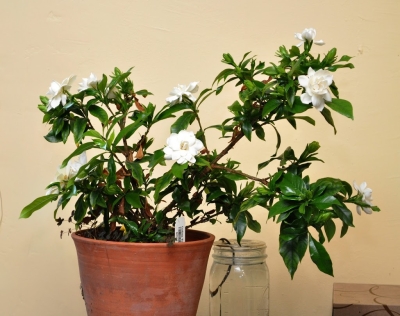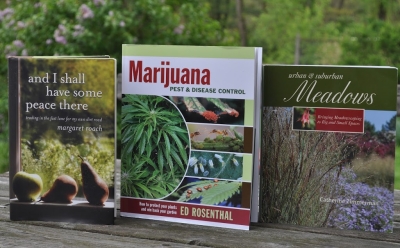Gardenias, Good books, and Spring Freeze
If I might brag a bit . . . It’s been just over a couple of years that, in the same breath and on these very pages, I bemoaned the loss and decided to again take up the challenge of growing gardenia. I purchased a new one, with which I now claim success. My plant is bushy with lush, glossy green leaves, nine creamy white blossoms are fully open, and buds foreshadowing more are on the way. Fragrance from each blossom is heavenly sweet.
Gardenia is a temperamental plant, ready to be attacked by scale insects, ready to drop its flower buds, and ready to let its leaves yellow and drop. For the scale insects, I sprayed the plants weekly at the end of last summer with a “horticultural oil” spray before cold weather creeping onwards ushered the plant indoors. This benign spray smothers the insects. I kept the plant on a sunny shelf next to my desk where I could keep a close eye out for the insects and when they started to appear in late winter, I sprayed the plant with Safers Soap.
I avoided leaf yellowing by using an acidic potting soil and with regular feeding using a water-soluble fertilizer, again beginning in late winter. Except for a few weeks of yellowing leaves, probably because the leaves were getting old (even evergreen leaves eventually get old, yellow, and drop), the leaves remained healthy and attached. I’ve never experienced drop of flower buds even though gardenias allegedly do so if moved to a different window or given any other slight change in conditions.
I credit most of my gardenial success to keeping the potting mix consistently moist. And, although I checked the soil often, I credit most of that consistent moisture to an automatic watering device I described two years ago. To quote myself, the device is “a porous, hollow spike, the pointed end of which gets pushed into the soil while its opposite, open end fits to a [thin] plastic tube the end of which sits in a jar of water. As the soil dries out, it sucks moisture out of the porous spike which, in turn, draws it in from the reservoir via the plastic tube.” It’s sometimes sold as a “Water Siphon” but also parades under such names as “Blumat,” “Hydrospike,” and “Ceramic Watering Probe.”
————————————————–
Now is the time to get hands dirty in the garden rather than to read about gardening. Nonetheless, 3 gardening books that crossed my desk are so noteworthy that they’re worth a look even now.
Marijuana Pest and Disease Control by Ed Rosenthal might raise a few eyebrows, but if I hadn’t already done my research and had experience with scale insects on my gardenia, Ed’s book would have been most useful. Marijuana is attacked by aphids, mold, fungus gnats — that is, by many of the same pests and diseases that attack our other plants, making Ed’s book a useful general guide to common pests and diseases. Because you don’t want to be smoking poison, the controls are organic.
Moving on, everyone knows the ecological nightmare that mowing, watering and pest and weed control can make of the average lawn. One attractive way to avoid the nightmare is to make your lawn smaller and let part of it become a meadow. Imagine the crisp edge of an expanse of mown lawn rising up to a sea of wildflowers and taller growing grasses with a mown path beckoning you to come within. Catherine Zimmerman’s Urban & Suburban Meadows is one of the clearest expositions for creating a meadow. With many photos and straightforward text, she leads the reader from ground preparation to planting to maintenance, also including plant lists and sources for supplies, plants, and further information. If I didn’t already have a meadow (entered via a meandering, mown path) and didn’t already have the book, I would buy it.
And finally, for a good read, there’s Margaret Roach’s And I Shall Have Some Peace There: Trading in the Fast Lane for My Own Dirt Road, a very engaging account of how Margaret traded in her job as editorial director for Martha Stewart Living Omnimedia for full-time life in her once-weekend home in rural Columbia County. The book is funny, open, and informative but, best of all, very well written. And Margaret has been a knowledgeable gardener for decades.
————————————————
Last night’s (April 29th) low of 26°F was, I hope the last freeze of this season. Hardy kiwi fruit vines awoke blackened and forlorn although I’m still not totally discounting the possibility of a crop from buds still to open. Many pear fruitlets are blackened within, dead. Apples look okay and, of course, pawpaws, berries, and persimmons are also okay.
Vegetables are easy! Any sort of covering thrown over them provides ample protection.
The last spring frost around here is, on average, shooed out the garden gate around the middle of May so I should not be surprised if another frost sneaks back in some night in the next two weeks.





